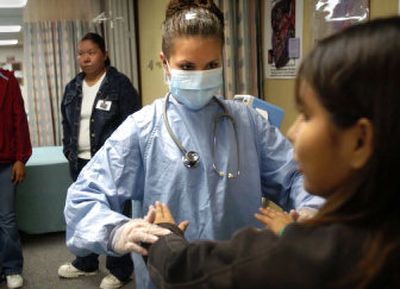Nursing with an Indian touch

Twenty-four high school students from around the West chipped away at a cultural inequity this week – though they might have thought they were just learning nursing skills and bunking at a Spokane college.
The students, representing 14 Native American tribes, attended the 10th annual Na-ha-shnee Native American Summer Nursing Institute, a weeklong camp geared for students interested in going into the medical field. As they learned how to treat wounds and measure blood pressure, they also were put on a springboard to a career that could help their communities one day.
“There have been great strides among Native Americans as far as improving health, but they still have some of the worst health disparities of any other ethnic group in the United States,” said Janet Katz, an assistant professor with the WSU Intercollegiate College of Nursing, which organizes the camp. “Having culturally competent health-care providers helps decrease the health disparities.”
Camp director Robbie Paul, the Native American Recruitment and Retention Coordinator at the school, added that exposing youths to career opportunities increases the chance they’ll attend college and perhaps return to their families, communities or reservations prepared to improve health care.
“This is starting at the pipeline,” Paul said. “To get them interested. To hook them.”
“Hooked” is one way to describe attendee Tristen James, a 16-year-old Shorewood High School student from Seattle. James attended Na-ha-shnee for the second consecutive summer, bolstering her goal to become a pediatrician for Native American tribes in Alaska.
James laughed when asked if other family members work in the medical field. Many haven’t even graduated from high school, she said.
“I wanted to go further and be successful,” said James, wearing a surgical gown and mask for a demonstration. “My whole family is so proud of me. They brag to everybody.”
Although the federal government spends more than $3 billion to deliver health care services to Native Americans each year, that population suffers from disease at a disproportionate rate than other Americans, according to a September 2004 report by the U.S. Commission on Civil Rights.
For example, Native Americans are 770 percent more likely to die from alcoholism, 650 percent more likely to die from tuberculosis, 420 percent more likely to die from diabetes and 280 percent more likely to die from accidents than other Americans.
Carla Norris, a Native American and Omak resident who helps at the Spokane camp, has seen those statistics come to life during her 35 years as a nurse.
“Diabetes is still the biggest one I see,” said Norris, 63. “For my generation, they think it’s inevitable. ‘I’m going to lose my feet anyway, why do anything about it?’ ” she hears people say.
Norris sees signs that the younger Native Americans aren’t as willing to accept that fate.
“This generation is finally getting that message,” she said.
One way to improve the health of Native Americans is to train more of them in the medical field, camp leaders said. When a patient is cared for by someone who understands their culture, they’re more likely to follow through with their treatment and feel as though their concerns were heard.
“It’s not that they’re resistant (to Western medicine), but their culture isn’t considered a lot of the time,” said camp counselor Tashina Nunez, a Yakama nation member who recently graduated from the nursing school. “The majority of nurses are Caucasian.”
The camp’s agenda aimed to bridge the cultural divide.
During the day, the students took classes related to Western medicine. They learned CPR, handled human organs in a cadaver lab and were taught about diseases.
Then, on Tuesday evening, the camp held a ceremony at Paul’s property and gathered traditional medicines from the land. They learned that fennel, an herb often used in cooking, can be put on a wound to draw the soreness out. Willow, when chewed, acts like aspirin. And bitterroot can be eaten raw or in soups to aid in body cleansing.
Nunez was as excited to learn about the traditional medicines as the students were. She took a diversity course in school, but the class focused on the diets of different ethnic cultures and understanding how religion affects interactions with patients.
She never learned about the traditional healing used in her own culture.
“I’ll be learning along with them,” Nunez said Tuesday morning.
Of course, another major goal of the camp is to create better futures for the attendees – not just their communities. In the past five years, 70 percent of Na-ha-shnee participants have gone on to college, whether to study nursing or some other subject, Katz said.
Some of the students in Spokane this week had never left home before or flown in an airplane. Students aren’t charged for the camp, which is sponsored by the nursing school, Group Health Community Foundation, the Trude Smith Fund and the WSU Creighton Endowment for Native American Students.
“It’s really important to take them away and show them the opportunities,” said Nunez, who first got a taste for higher education at a science camp in Pullman, although she’d always been interested in nursing.
John Duran, 16, traveled from Salem for the camp. The Oglala Sioux Indian wants to work as a nurse one day on the Pineridge Reservation in South Dakota, where his mom used to live.
Duran, one of three boys at the camp, said his friends think his career goal is “cool, because I’m trying something that most guys don’t do.”
Now if the dorm rooms at camp just had televisions, he griped with a smile.